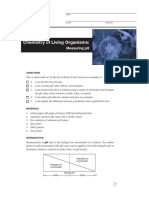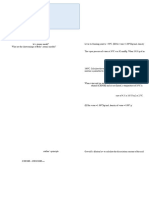(In Vacuum With Medium Dielectric Constant 1
Uploaded by
Karthik Sharma(In Vacuum With Medium Dielectric Constant 1
Uploaded by
Karthik SharmaBirla Institute of Technology & Science, Pilani, Rajasthan 333031
I Semester, 2006-2007
Course Number: CHEM C141 Course Title: Chemistry I Marks: 6
Tutorial Problem Set 2 (based on Lecture No.’s: 8-14 in the course handout)
Instructions to the student: The following problems should be solved as home assignment
within a week of distribution. The respective tutorial hour instructor will assign any one problem
as a closed book class test in the following tutorial hour. Do not misplace this sheet. Bring it with
you for the next tutorial hour. Solve and submit the assigned problem to the instructor. Carefully
write your name and ID no. on your answer sheet. Write legibly and do not overwrite. Strike out
clearly the rough work if any. Do not write anything in this sheet other than your name and ID.
Useful data: ε0 = 8.85419 × 10-12 J-1C2m-1, Atomic No. for B = 5, N = 7, F =9, S = 16, Cl = 17
1D = 3.33564 × 10-30 C m.
1. Draw all the resonating forms for ozone (O3), boron trifluoride (BF3), nitrate anion (NO3-),
nitrite anion (NO2-), sulfate anion (SO4-2) and carbonate anion (CO3-).
2. Write electronic configuration of the followings
(a) Fe(26) (b) Fe3+(23) (c) Sc(21) (d) Cr(24) (e) S (32) (f) Cu(29)
3. Why does N2 has greater dissociation energy than N2+2 whereas O2 has lower dissociation
energy than O2+ ?
4. (a) Determine the atomic term symbols for electrons for which L = 2 and S = 1. (b) Predict
whether the molecules SF6, NH3, CO2, H2O, CHCl3 and CCl4 will have dipole moments.
5. Determine the atomic term symbol for (a) hydrogen atom (b) Helium atom in ground state
and excited state.
6. Write Lewis structures (structures in which each electron pair bond is designated by
a line joining the nuclei and dots are used to designate unshared electrons in the
valency shell) for SCN-, N3-, CO2, HF, NH4+, SO2
7. Give the molecular electronic configuration for each species: O2+, O2, O2-, O2-2 and
predict (a) which species are paramagnetic (b) the order of increasing bond
dissociation energy among the species.
8. (a) Two HCl molecules (µ = 1.08 D) are separated by 4.0 Å (400 pm) in air. Calculate (in
-1
vacuum with medium dielectric constant = 1) the dipole-dipole interaction energy in kJmol
if they oriented end-to-end, that is H-Cl H-Cl, considering HCl as point dipole.
(b) Explain why ammonia is soluble in water but nitrogen trichloride is not.
9. The bond angle in H2S is 97º and its dipole moment is 1.47 D. Find the S-H bond moment.
Estimate the percentage of ionic character of the S-H bond in H2S. The S-H bond distance
is 0.1334 nm.
10. Write electronic configuration for C2, B2 and N2. Explain why C2 and B2 are paramagnetic
whereas N2 is diamagnetic.
You might also like
- Chemistry 20 Unit D Stoichiometry Quiz Questions0% (1)Chemistry 20 Unit D Stoichiometry Quiz Questions6 pages
- Chemistry of Living Organisms Measuring PH Lab Activity PDFNo ratings yetChemistry of Living Organisms Measuring PH Lab Activity PDF6 pages
- Chemistry: Delhi Public School Ruby Park, Kolkata Class - XINo ratings yetChemistry: Delhi Public School Ruby Park, Kolkata Class - XI3 pages
- ASK14RIP112PT01 (O) General InstructionsNo ratings yetASK14RIP112PT01 (O) General Instructions3 pages
- Xi Chemistry (Set-A) Final Term 2023-24 (110 Copies)No ratings yetXi Chemistry (Set-A) Final Term 2023-24 (110 Copies)7 pages
- SHREE POKHARIYA SECONDARY SCHOOL Class 11 Tech.No ratings yetSHREE POKHARIYA SECONDARY SCHOOL Class 11 Tech.2 pages
- Chemistry: Cbse Sample Paper For Class-12No ratings yetChemistry: Cbse Sample Paper For Class-1218 pages
- Class 11 Chemistry em May 2022 Answer Key V.suresh Kanna, P.g.asst, GHSS, ThirumanjolaiNo ratings yetClass 11 Chemistry em May 2022 Answer Key V.suresh Kanna, P.g.asst, GHSS, Thirumanjolai9 pages
- Namma Kalvi 11th Chemistry Revision Test Question Papers EM 221210No ratings yetNamma Kalvi 11th Chemistry Revision Test Question Papers EM 22121010 pages
- L.S.F. CHM201 Exam 2 L.S.F.: Always Ready To Help!No ratings yetL.S.F. CHM201 Exam 2 L.S.F.: Always Ready To Help!0 pages
- Chemistry Class XI Unsolved Sample Paper 1No ratings yetChemistry Class XI Unsolved Sample Paper 14 pages
- Namma Kalvi 11th Chemistry Government Model Question Paper With Answer Key EMNo ratings yetNamma Kalvi 11th Chemistry Government Model Question Paper With Answer Key EM16 pages
- Namma Kalvi 11th Chemistry Government Model Question Paper With Answer Key EM PDFNo ratings yetNamma Kalvi 11th Chemistry Government Model Question Paper With Answer Key EM PDF16 pages
- HOME PACKAGE FV& FVI 2024.. ADVANCE CHEMISTRY SERIESNo ratings yetHOME PACKAGE FV& FVI 2024.. ADVANCE CHEMISTRY SERIES16 pages
- Goldengate Int'L College: First Terminal Examination-2080No ratings yetGoldengate Int'L College: First Terminal Examination-20802 pages
- Autumn Break Assignment - CLASS XI BBK 2023No ratings yetAutumn Break Assignment - CLASS XI BBK 20232 pages
- Half Yearly Examination SESSION 2015 - 16 Class Xi Subject - ChemistryNo ratings yetHalf Yearly Examination SESSION 2015 - 16 Class Xi Subject - Chemistry4 pages
- Endohedral Metallofullerenes: Fullerenes with Metal InsideFrom EverandEndohedral Metallofullerenes: Fullerenes with Metal InsideNo ratings yet
- Infrared Spectroscopy of Diatomics for Space ObservationFrom EverandInfrared Spectroscopy of Diatomics for Space ObservationNo ratings yet
- Amorphous Semiconductors: Structural, Optical, and Electronic PropertiesFrom EverandAmorphous Semiconductors: Structural, Optical, and Electronic PropertiesNo ratings yet
- Acid Derivatives: Nucleophilic Substitution: Alkyl vs. AcylNo ratings yetAcid Derivatives: Nucleophilic Substitution: Alkyl vs. Acyl10 pages
- Carboxylic Acids: Some Important Acids and Their Structural Formula'sNo ratings yetCarboxylic Acids: Some Important Acids and Their Structural Formula's11 pages
- Acid Derivatives: Nucleophilic Substitution: Alkyl vs. AcylNo ratings yetAcid Derivatives: Nucleophilic Substitution: Alkyl vs. Acyl10 pages
- Carboxylic Acids: Some Important Acids and Their Structural Formula'sNo ratings yetCarboxylic Acids: Some Important Acids and Their Structural Formula's11 pages
- Molecular Orbitals and Hybridisation: Organic ChemistryNo ratings yetMolecular Orbitals and Hybridisation: Organic Chemistry28 pages
- Tabel 1. Unsur-Unsur Yang Sudah DitemukanNo ratings yetTabel 1. Unsur-Unsur Yang Sudah Ditemukan1 page
- Drug Design: Functional Groups / Pharmacological ActivityNo ratings yetDrug Design: Functional Groups / Pharmacological Activity24 pages
- Self-Study On API RP 571 - Damage Mechanism67% (3)Self-Study On API RP 571 - Damage Mechanism84 pages
- Laboratory Report Chm421: Experiment 6A: Analysis of Bleach and Copper (Ii) UnknownNo ratings yetLaboratory Report Chm421: Experiment 6A: Analysis of Bleach and Copper (Ii) Unknown13 pages
- A Gel To Control The Spontaneous Combustion of Coal As Fire PreventionNo ratings yetA Gel To Control The Spontaneous Combustion of Coal As Fire Prevention5 pages
- Self-Sealing, Autogenous Healing and Continued Hydration: What Is The Difference?No ratings yetSelf-Sealing, Autogenous Healing and Continued Hydration: What Is The Difference?5 pages
- Treatment of A Copper-Rich Gold Ore by C PDFNo ratings yetTreatment of A Copper-Rich Gold Ore by C PDF11 pages
- As Chemistry Unit 1 Key Notes and AnswersNo ratings yetAs Chemistry Unit 1 Key Notes and Answers71 pages
- Bio Molecules Pattern Matching - High School BiologyNo ratings yetBio Molecules Pattern Matching - High School Biology9 pages





































































































